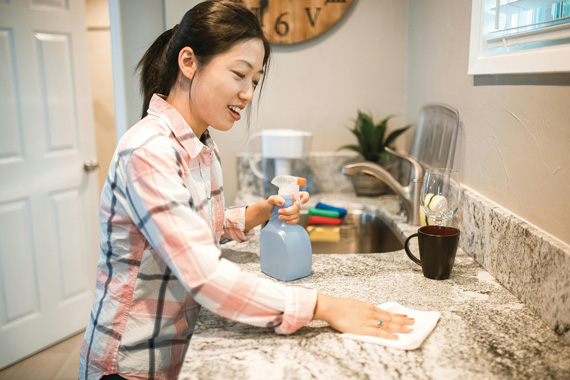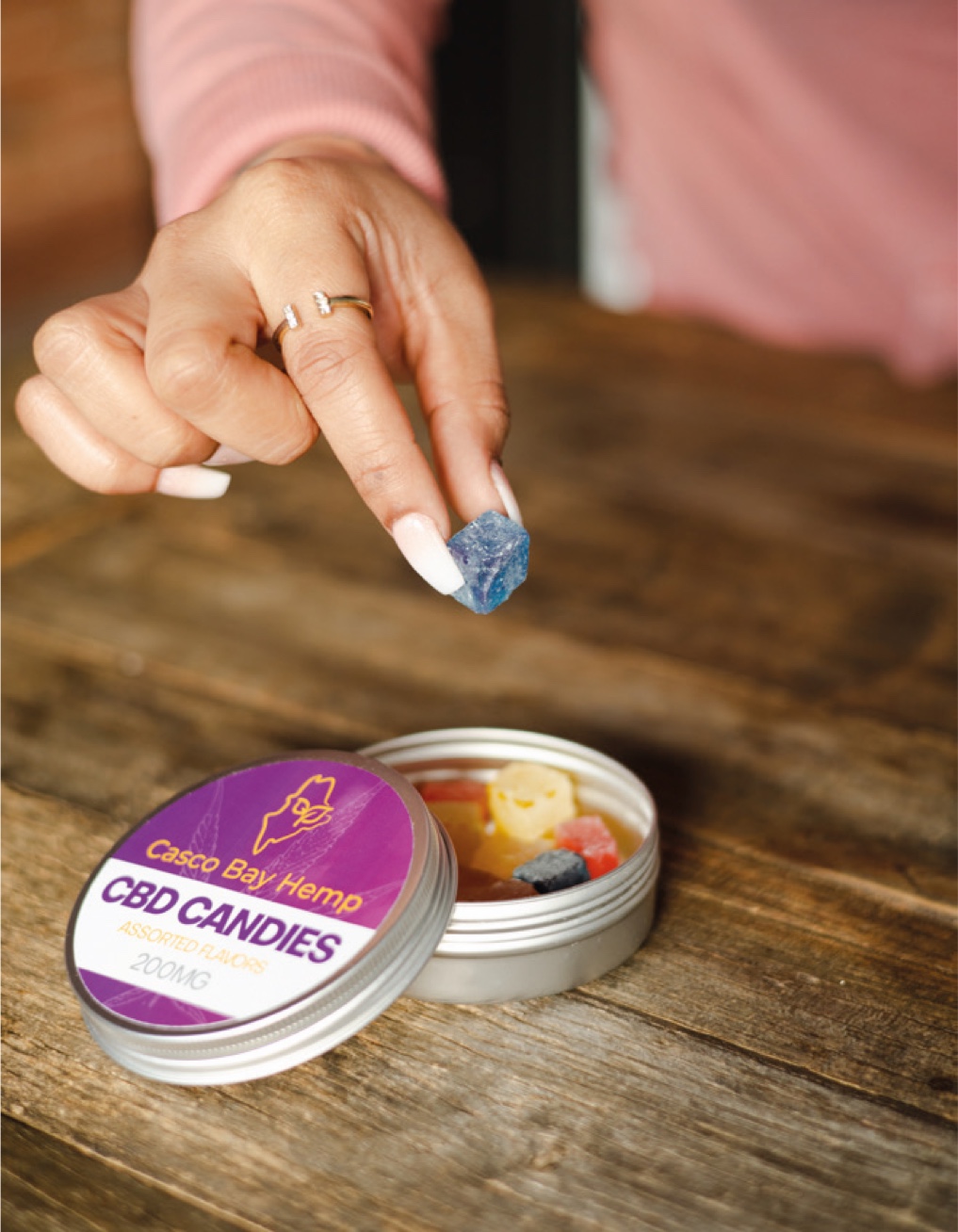Column: CONSUMER PERSPECTIVE
Scent as Self-Care - The New Role
of Fragrance in Home Cleaning
KEYWORDS —
WELLBEING;
SELF-CARE;
FRAGRANCE;
MOOD;
PSYCHOLOGY;
EMOTION.
COSMETIC COMPLIANCE.
Abstract
Studies of major depressive disorder have been correlated with reduced Lactobacillus and Bifidobacteria and symptom severity has been correlated to changes in Firmicutes, Actinobacteria, and Bacteriodes. Gut microbiota that contain more butyrate producers have been correlated with improved quality of life (1).
A study in healthy women providing probiotic yogurt for four weeks showed an improvement in emotional responses as measured by brain scans (2). A subsequent study by Mohammadi et al. (3) investigated the impacts of probiotic yogurt and probiotic capsules over 6 weeks and found a significant improvement in depression-anxiety-stress scores in subjects taking the specific strains of probiotics contained in the yogurt or capsules. Other studies with probiotics have indicated improvements in depression scores, anxiety, postpartum depression and mood rating in an elderly population (4-7).
Other studies have indicated a benefit of probiotic supplementation in alleviating symptoms of stress. In particular, researchers have looked at stress in students as they prepared for exams, while also evaluating other health indicators such as flu and cold symptoms (1). In healthy people, there is an indication that probiotic supplementation may help to maintain memory function under conditions of acute stress.
“
“A study in healthy women providing probiotic yogurt for four weeks showed an improvement in emotional responses as measured by brain scans”
Wellbeing has become one of the most powerful forces shaping consumer behavior. Once reserved for categories like beauty, fitness, or nutrition, the language of self-care has steadily expanded into every corner of daily life. Consumers now see wellness not just as what they put in their bodies, but also what surrounds them at home.
This shift shows up clearly in home care. Cleaning is no longer framed solely as a task to fight dirt and germs. Instead, it’s being reframed as an act of care for the home, for the family, and increasingly, for the self. A clean space promises not just hygiene but also a sense of calm, control, and even emotional reset. In other words, cleaning products are stepping into the same wellbeing territory once dominated by skincare or spa rituals.
Major players are already leaning in. Clorox recently launched its “Clean Feels Good” campaign, reframing cleaning from a chore into an act of emotional wellbeing. Backed by neuroscience research using EEG, the brand showed that everyday tasks like wiping a counter or scrubbing a toilet could trigger more positive feelings than traditionally pleasurable activities like petting puppies or even getting a massage. By positioning cleaning as a source of feel-good self-care, Clorox has demonstrated how powerful the wellbeing frame can be in home care.
If cleaning itself can deliver measurable emotional uplift, then fragrance is the natural next lever. Long central to how consumers judge cleanliness, scent now also shapes how people feel during and after the act. Scents once designed to reassure us that a space was “fresh” or “sanitized” are increasingly expected to deliver mood benefits: lavender to calm, citrus to energize, vanilla to comfort. This makes fragrance not just an accessory, but a core driver of home care’s new role as self-care. But can they really accomplish that? For developers, the challenge is proving these benefits are more than marketing stories; the opportunity is to harness scent as a genuine tool for wellbeing, backed by evidence.
Why Self-Care in Home Care is a Smart Target
From a behavioral science perspective, it makes perfect sense that cleaning is being pulled into the self-care space. People are far more likely to stick with routines when those routines are tied to positive reinforcement and identity rather than obligation alone. When the act of cleaning comes with a sensory lift—a calming fragrance, an energizing burst of citrus—it transforms from drudgery into something rewarding, even restorative.
Chores can also serve an important role in emotional regulation. They offer a moment of mindfulness, a sense of control, and the small psychological boost that comes from completing a task. When framed this way, cleaning becomes less about what you’re fighting against (dirt, germs, mess) and more about what you’re moving toward: calm, order, and wellbeing.
Academic research supports this. Identity-based motivation shows that people are more likely to adopt and maintain behaviors when they see them as consistent with who they are or who they want to be. A routine framed as self-care allows consumers to think of themselves as “someone who cares for their wellbeing” or “someone who creates a nurturing space for their family.” Similarly, self-determination theory suggests that behaviors are more likely to persist when they fulfill intrinsic psychological needs such as autonomy, competence, and relatedness. Reframing cleaning as self-care checks these boxes: it’s a choice, it offers a sense of mastery, and it connects to the wellbeing of loved ones.
For developers, this shift is powerful. Products that support these psychological levers of reward, regulation, and identity are more likely to be woven into daily life not just out of necessity, but out of genuine desire.
Measuring the Scent–Emotion Link
The question, of course, is how to demonstrate that fragrance truly delivers on these self-care benefits. And here’s the hard truth: it’s not easy. Emotions are fleeting, multi-layered, and heavily influenced by context (Russell, 2003). Consumers may say they feel calmer or more energized, but what they report isn’t always the whole story and what they actually do may tell yet another. For developers, this means that proving fragrance has a measurable impact requires careful study design and, often, multiple methods.
The starting point is usually self-report. Qualitative interviews or focus groups, mood scales, emotion grids, or descriptive word lists can capture how people say they feel before and after using a scented product. These tools are straightforward and give you the consumer language you need, but they’re vulnerable to bias. People often report what they think they should feel, or what makes sense in the moment. But may not even be capable of self reporting or even recalling how they felt in the moment of the experience.
That’s why researchers often opt to go deeper with their approach, using methods that capture automatic reactions that happen too quickly or subtly to articulate. Implicit association tasks can uncover how strongly a scent like lavender is tied to, or associated with, the idea of calm or citrus to vitality, while physiological signals, like heart rate variability or changes in skin conductance, provide another window into the body’s response. These measures are powerful, but they’re also noisy and context-dependent, which makes interpretation tricky.
Even then, the most persuasive evidence usually comes from behavior itself. Do people spend longer cleaning with a product that carries an energizing fragrance? Do they reach for certain scents more often when they’re stressed compared to when they want a boost? Behavior connects fragrance to real-world outcomes, but even here, controlling for habit, preference, and situational factors adds layers of complexity to proving efficacy.
This is why the strongest case is made when multiple perspectives line up. If consumers report feeling calmer, demonstrate quicker associations between a fragrance and calmness, and also show physiological markers of relaxation after use, the story becomes much more convincing. That’s when fragrance benefits begin to move out of the realm of marketing story and into something evidence-based and actionable for innovation. But reaching that point takes rigor, patience, and the recognition that measuring emotions in home care is as challenging as it is rewarding.


Proving Efficacy for Product Development
For product developers, the real challenge isn’t just in gathering data; it’s in turning insights into evidence that can withstand scrutiny from consumers, competitors, and regulators alike. This is where triangulation becomes critical. By combining self-reports with implicit measures and observable behavior, developers can create a layered picture of how fragrance contributes to wellbeing. Each approach alone has blind spots, but together they provide converging evidence that strengthens confidence in the findings.
Importantly, efficacy must go beyond the functional. It’s one thing for a product to be perceived as effective (“it smells clean”), but the real differentiator is emotional impact: “I feel calmer after using it.” Showing that a fragrance not only signals cleanliness but also improves mood, reduces stress, or provides a sense of comfort gives developers a richer platform for innovation and positioning.
But research data must be distilled into consumer-facing claims that are both compelling and credible. Rather than relying on vague promises of “mood-boosting scents,” brands can ground their messaging in specific outcomes: “72% of users reported feeling more relaxed after cleaning with this fragrance,” or “Independent testing showed that this scent increased feelings of energy compared to an unscented product.” These types of claims bridge scientific rigor with language that resonates in everyday decision-making. And it is advised to follow ASTM guidelines for how to do this properly.
Of course, this comes with its own challenges. Regulatory environments vary by market, and claims around emotions or wellbeing must be carefully substantiated to avoid overreach. Overpromising risks eroding consumer trust, especially in a space where skepticism about “wellness-washing” is growing. The opportunity for developers, then, is to use behavioral science not only as a research toolkit but as a guardrail for credibility. Strong evidence enables bold but honest storytelling, positioning products as part of consumers’ broader self-care rituals in a way that feels both aspirational and trustworthy.
In short, proving efficacy in this space is difficult, but the payoff can be significant. When brands can show (with data) that fragrance delivers measurable self-care benefits, they elevate home care products from functional tools to emotional allies. That’s where the future of the category lies.

The Takeaway for Product Developers
For developers, the message is clear: scent is no longer just a mask for odors or a simple signal of cleanliness. It has become a wellbeing lever. Consumers are increasingly looking for products that do more than perform; they want products that feel good to use and that leave behind a sense of calm, energy, or comfort. Designing with these emotional outcomes in mind is one of the most effective ways to differentiate in a category where basic efficacy is often assumed.
Behavioral science provides the toolkit to make this shift credible. By combining explicit reports of mood, implicit measures of emotional associations, and behavioral outcomes tied to real-world use, developers can move beyond intuition and marketing language to measurable, validated benefits. This not only strengthens claims but also protects against the risk of overpromising in an era where consumers are quick to spot “wellness-washing.”
The opportunity for home care lies in reimagining cleaning as more than a functional chore. Fragrance, when designed and tested with care, has the power to transform routine cleaning into a mood-enhancing wellness ritual, a small but meaningful moment of self-care woven into everyday life. In a crowded marketplace, products that deliver both performance and emotional payoff will stand out, earn trust, and build stronger, longer-lasting connections with consumers.

Studies of major depressive disorder have been correlated with reduced Lactobacillus and Bifidobacteria and symptom severity has been correlated to changes in Firmicutes, Actinobacteria, and Bacteriodes. Gut microbiota that contain more butyrate producers have been correlated with improved quality of life (1).
A study in healthy women providing probiotic yogurt for four weeks showed an improvement in emotional responses as measured by brain scans (2). A subsequent study by Mohammadi et al. (3) investigated the impacts of probiotic yogurt and probiotic capsules over 6 weeks and found a significant improvement in depression-anxiety-stress scores in subjects taking the specific strains of probiotics contained in the yogurt or capsules. Other studies with probiotics have indicated improvements in depression scores, anxiety, postpartum depression and mood rating in an elderly population (4-7).
Other studies have indicated a benefit of probiotic supplementation in alleviating symptoms of stress. In particular, researchers have looked at stress in students as they prepared for exams, while also evaluating other health indicators such as flu and cold symptoms (1). In healthy people, there is an indication that probiotic supplementation may help to maintain memory function under conditions of acute stress.
References and notes
- ASTM International. (2022). ASTM E1958-22: Standard Guide for Sensory Claim Substantiation. ASTM International.
- Baumeister, R. F., Vohs, K. D., & Funder, D. C. (2007). Psychology as the science of self-reports and finger movements: Whatever happened to actual behavior?. Perspectives on psychological science, 2(4), 396-403.
- Deci, E. L., & Ryan, R. M. (1985). Conceptualizations of intrinsic motivation and self-determination. In Intrinsic motivation and self-determination in human behavior (pp. 11-40). Boston, MA: Springer US.
- Greenwald, A. G., McGhee, D. E., & Schwartz, J. L. (1998). Measuring individual differences in implicit cognition: the implicit association test. Journal of personality and social psychology, 74(6), 1464.
- Kreibig, S. D. (2010). Autonomic nervous system activity in emotion: A review. Biological psychology, 84(3), 394-421.
- Oyserman, D. (2009). Identity-based motivation: Implications for action-readiness, procedural-readiness, and consumer behavior. Journal of Consumer Psychology, 19(3), 250-260.
- Russell, J. A. (2003). Core affect and the psychological construction of emotion. Psychological review, 110(1), 145.
- Santos, R. (2025, March 11). Clorox rethinks what feels good in new brand platform. The Clorox Company. Retrieved [August 10, 2025], from https://www.thecloroxcompany.com/blog/clorox-rethinks-what-feels-good-in-new-brand-platform/
- Schwarz, N. (1999). Self-reports: How the questions shape the answers. American psychologist, 54(2), 93.

